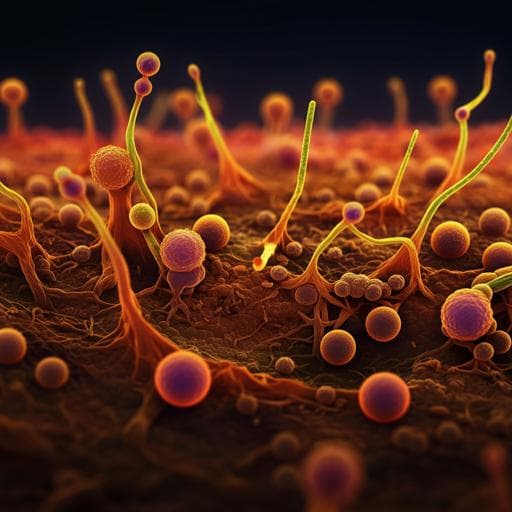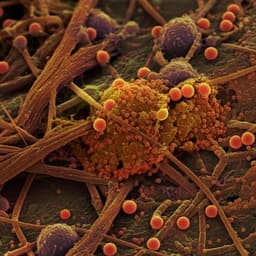
Agriculture
Integrating microbial community properties, biomass and necromass to predict cropland soil organic carbon
C. Wang, X. Wang, et al.
Discover how manipulating microorganisms can boost soil organic carbon in croplands! This groundbreaking research by Chao Wang, Xu Wang, Yang Zhang, Ember Morrissey, Yue Liu, Lifei Sun, Lingrui Qu, Changpeng Sang, Hong Zhang, Guochen Li, Lili Zhang, and Yunting Fang reveals the crucial links between microbial properties and soil carbon levels across northeast China.
~3 min • Beginner • English
Introduction
Terrestrial soils have substantial potential (~3.2 Pg C yr−1) for carbon sequestration, yet croplands often exhibit depleted soil organic carbon (SOC) relative to natural ecosystems due to practices such as cultivation, residue removal, and accelerated decomposition. Enhancing SOC in croplands is a scalable climate solution, with global cropland sequestration potential estimated at 0.90–1.85 Pg C yr−1. Microorganisms regulate SOC decomposition and formation, and microbial necromass (dead cells and residues) can contribute 50–80% of SOC; its persistence depends on chemistry and mineral interactions. Microbial community properties (diversity, composition, and network interactions) can shape necromass formation and stabilization through effects on microbial growth efficiency, death pathways, and interspecies interactions, potentially differing by crop type. Northeast China croplands have experienced substantial SOC depletion over 150 years. This study surveyed 468 cropland soils (349 maize, 119 rice) in Liaoning province to (1) quantify relationships between microbial community properties (diversity, network complexity), microbial carbon pools (biomass, necromass), and SOC, and (2) develop crop-specific predictive SOC models incorporating microbial parameters. The authors hypothesized that microbial necromass C would explain a large portion of SOC variation, with crop-specific differences, and that including microbial parameters would improve SOC predictions.
Literature Review
Methodology
Study region and sampling: Liaoning province, northeast China, spanning temperate to continental monsoon climates; growing season precipitation 450–1200 mm and temperature 4.6–10.3 °C. Soils include Aridisols, Alfisols, Inceptisols, Entisols (USDA). From Sept–Oct 2019, 468 fields were sampled: 349 maize and 119 rice, each cultivated ≥20 years. At each site, five 100 m² plots were established; five 0–15 cm soil cores (2.5 cm diameter) per plot were combined into one composite sample per site. Fresh soils were sieved (2 mm), visible plant material removed, transported on dry ice. Subsamples stored at 4 °C for microbial biomass C, dissolved organic C, dissolved total N, available P, water content; air-dried subsamples for pH, SOC, total N, total P, fungal and bacterial necromass C; remaining soils stored at −80 °C for DNA extraction.
Soil physicochemical analyses: pH measured at 1:2.5 soil:water; soil water content by oven drying; SOC and total N via elemental analyzer (Flash EA, Thermo Fisher) after ball milling; total P by digestion; available P by Olsen-P extraction and SmartChem140 analyzer.
Microbial biomass C: Chloroform fumigation-extraction (Vance et al.); fresh soil (20 g) extracted with 0.5 M K2SO4 (80 mL) pre- and post-fumigation (24 h, ethanol-free chloroform, dark). TOC in extracts measured (Shimadzu TOC analyzer). Conversion factor kEC = 0.45.
Microbial necromass C: Amino sugars (glucosamine, galactosamine, muramic acid) determined per Zhang & Amelung. Bacterial necromass C calculated as MurA × 45; fungal necromass C as (GluN/179.17 − 2 × MurA/251.23) × 179.17 × 9. Total necromass C = bacterial + fungal.
Amplicon sequencing: DNA from 0.5 g freeze-dried soil using QIAGEN kit; quality via NanoDrop. Bacteria: 16S rRNA V4–V5 with primers 515F/806R; Fungi: ITS1 region with ITS1/ITS2 primers. PCR conditions provided for each marker. Libraries via Illumina Nextera; MiSeq 2×250 bp; sequencing performed at Institute of Applied Ecology (Shenyang). Quality filtering removed reads <200 bp, Q<20, ambiguous bases, primer/barcode mismatches; singletons/doubletons removed. Processed with VSEARCH and QIIME2; ASVs at 100% similarity (UPARSE workflow). Rarefaction to 16,450 bacterial reads and 6,750 fungal reads per sample. Taxonomy via RDP classifier against SILVA v138 (bacteria) and UNITE v9.0 (fungi). Alpha diversity: observed species, Shannon index; beta diversity: Bray–Curtis PCoA.
Microbial co-occurrence networks: Constructed separate bacteria-fungi internetworks for maize and rice using R packages igraph and psych. Excluded ASVs with relative abundance <0.01%. Spearman correlations computed on merged bacterial+fungal ASV table; Benjamini–Hochberg FDR-adjusted P<0.001 and correlation coefficient ≥0.7 retained. Network topology parameters: node number (n), average connectivity (average K), centralization of betweenness (CB), clustering coefficient (CC), centralization of degree (CD), density (Den), average path length (average L). Principal components (Network PC1, PC2) of these seven metrics summarized network complexity. Modules identified in Gephi.
Statistical analyses: Differences between maize and rice for SOC, microbial biomass C, microbial necromass C, pH, available P, N/P ratio, soil water content, and alpha diversity tested by one-way ANOVA (Levene’s test for homogeneity; Shapiro test for normality). Microbial community composition compared by PERMANOVA (vegan). Network metric differences by Wilcoxon rank-sum.
SOC prediction modeling: Predictors included climate (mean growing season precipitation, temperature), soil properties (pH, N/P ratio, available P, soil water content), microbial carbon pools (microbial biomass C, microbial necromass C), and microbial community properties (bacterial and fungal diversity, Network PC1, Network PC2). Due to collinearity among necromass components, only total microbial necromass C used in models. All variables Z-standardized. Multiple regression with all-subset selection using MuMin, ranked by AIC (ML). Models with ΔAIC<2 averaged (model.avg) to estimate parameters and P-values; relative effects computed as parameter estimate proportion. Competing model sets: (1) full (climate + soil + microbial pools + community), (2) without community properties, (3) without microbial carbon pools, (4) climate+soil only. Best model chosen by lowest AIC. Structural equation modeling (SEM) used to assess pathways: first, regress SOC on climate and soil to obtain residuals; then fit SEM among microbial pools, community properties, and SOC residuals using maximum likelihood (fit indices: χ2, P, R2, CFI).
Key Findings
- SOC and microbial pools by crop: Rice soils had higher SOC (16.1 ± 6.1 g/kg) than maize (12.6 ± 6.2 g/kg). Microbial biomass C (MBC) was higher in rice (0.21 ± 0.09 g/kg) than maize (0.13 ± 0.06 g/kg). Microbial necromass C (MNC) was higher in maize (4.71 ± 1.54 g/kg) than rice (3.90 ± 1.19 g/kg). The MNC/SOC ratio was higher in maize (41.2% ± 13.6) than rice (27.1% ± 13.0).
- Community composition and diversity: Bacterial and fungal community compositions differed significantly between maize and rice (PERMANOVA, P<0.001). Alpha diversity (observed species, Shannon index) was higher in maize for both bacteria and fungi (P<0.001).
- Network properties: Co-occurrence networks displayed scale-free structures. Network topologies differed between crops; module taxonomic composition also differed (e.g., maize modules dominated by Proteobacteria, Actinobacteria; rice modules included Proteobacteria, Chloroflexi, Mortierellales). Network complexity summarized by PC1 and PC2 explained 44.2%/23.8% of variance in maize and 48.6%/21.6% in rice.
- Correlations with SOC: Microbial necromass C (and its bacterial/fungal components) positively correlated with SOC in both crops. MBC positively correlated with SOC in maize but not in rice.
- SOC prediction models: The best-performing models for both crops included microbial community properties and microbial C pools (lowest AIC; highest adjusted R2). Maize model: adj. R2 = 0.45; significant predictors included MBC, MNC, bacterial diversity, and Network PC1; microbial C pools explained 31.7% and community properties 23.9% of the explained variance. Rice model: adj. R2 = 0.55; soil properties (especially soil N/P ratio) explained 57.7% of SOC variation; microbial necromass C plus community properties (Network PC1, bacterial diversity) explained 25.7%.
- SEM insights: In maize, MNC and MBC had direct positive effects on SOC; network complexity and diversity affected SOC directly and indirectly via MBC and MNC. In rice, MNC had a positive effect on SOC while MBC did not; network properties linked to SOC directly and indirectly via diversity and MNC. Overall, in maize, microbial diversity and MBC were the top microbial predictors of SOC; in rice, network properties and MNC were most important.
- Fungal vs bacterial necromass: Fungal necromass composed the majority of necromass C (mean ~74% in maize; ~75% in rice), suggesting a larger fungal contribution to SOC accumulation in these croplands.
Discussion
The study demonstrates that integrating microbial properties related to both life (biomass production, diversity, network complexity) and death (necromass) improves prediction of cropland SOC. Microbial necromass was consistently and positively associated with SOC in maize and rice, supporting the concept that microbial residues are major contributors to soil organic matter. Crop-specific differences emerged: rice soils had higher SOC but a lower proportion derived from necromass (likely due to oxygen limitation in waterlogged paddies reducing microbial anabolism and promoting plant residue accumulation), whereas maize soils exhibited higher microbial diversity, network complexity, necromass pools, and MNC/SOC ratios. Fungal necromass dominated necromass pools, aligning with its slower decomposition, recalcitrant components, and enhanced physical protection within aggregates, thus contributing more strongly to SOC accumulation than bacterial residues. Modeling showed that microbial parameters significantly enhance SOC predictive power beyond climate and soil properties alone, though their relative importance differs by crop: in maize, MBC and diversity were key; in rice, network complexity and necromass C were more influential, while soil nutrient stoichiometry (N/P) played the largest overall role. SEM further clarified direct and indirect pathways linking community properties to SOC through effects on microbial biomass and necromass. These findings underscore the value of a microbial life-cycle perspective (community, growth, turnover, necromass) for managing SOC in croplands and suggest that practices enhancing microbial C use efficiency, favorable interactions, and necromass stabilization can promote SOC accrual, with strategies tailored by crop type.
Conclusion
Microbial parameters are critical for explaining and predicting SOC in croplands at regional scales. Fungal necromass contributes more to SOC accumulation than bacterial necromass. Microbial diversity, network complexity, and living biomass C directly and indirectly influence necromass formation and SOC levels. Including both microbial community properties and microbial carbon pools substantially improves SOC prediction models, though their relative importance differs between maize and rice. Management practices that enhance microbial diversity, network complexity, microbial growth efficiency, and necromass stabilization are promising avenues to increase SOC in croplands. Future work should refine crop-specific models and management frameworks that integrate microbial living biomass, necromass, and community properties.
Limitations
No explicit limitations section is provided. The authors note the need for further research to disentangle direct versus indirect effects of soil nutrients on SOC, and to better integrate microbial parameters into SOC models across crop types. Findings are based on a regional survey in Liaoning province and use amino sugar proxies for necromass and co-occurrence network analyses to infer community interactions.
Related Publications
Explore these studies to deepen your understanding of the subject.







